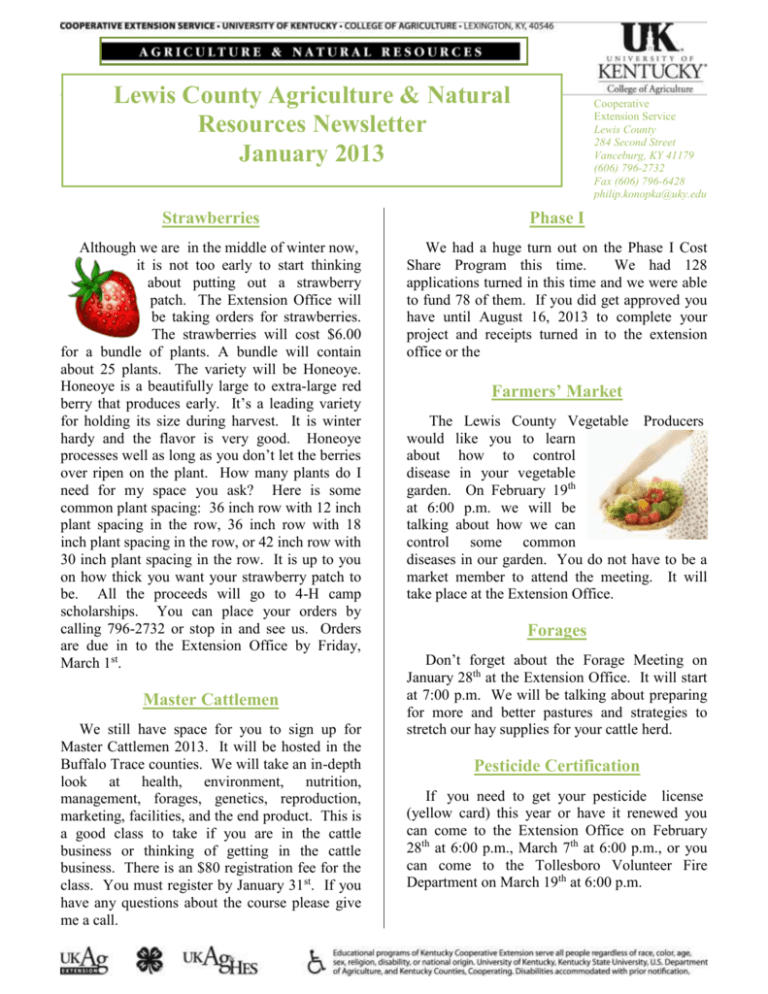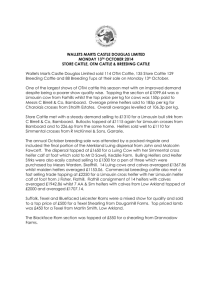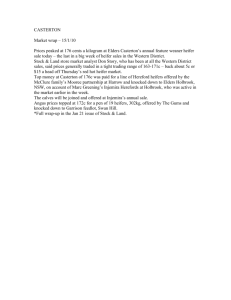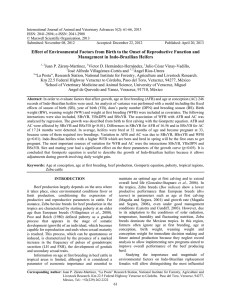Department/Unit Name - Lewis County Cooperative Extension
advertisement

Lewis County Agriculture & Natural Resources Newsletter January 2013 Cooperative Extension Service Lewis County 284 Second Street Vanceburg, KY 41179 (606) 796-2732 Fax (606) 796-6428 philip.konopka@uky.edu Strawberries Phase I Although we are in the middle of winter now, it is not too early to start thinking about putting out a strawberry patch. The Extension Office will be taking orders for strawberries. The strawberries will cost $6.00 for a bundle of plants. A bundle will contain about 25 plants. The variety will be Honeoye. Honeoye is a beautifully large to extra-large red berry that produces early. It’s a leading variety for holding its size during harvest. It is winter hardy and the flavor is very good. Honeoye processes well as long as you don’t let the berries over ripen on the plant. How many plants do I need for my space you ask? Here is some common plant spacing: 36 inch row with 12 inch plant spacing in the row, 36 inch row with 18 inch plant spacing in the row, or 42 inch row with 30 inch plant spacing in the row. It is up to you on how thick you want your strawberry patch to be. All the proceeds will go to 4-H camp scholarships. You can place your orders by calling 796-2732 or stop in and see us. Orders are due in to the Extension Office by Friday, March 1st. We had a huge turn out on the Phase I Cost Share Program this time. We had 128 applications turned in this time and we were able to fund 78 of them. If you did get approved you have until August 16, 2013 to complete your project and receipts turned in to the extension office or the Master Cattlemen We still have space for you to sign up for Master Cattlemen 2013. It will be hosted in the Buffalo Trace counties. We will take an in-depth look at health, environment, nutrition, management, forages, genetics, reproduction, marketing, facilities, and the end product. This is a good class to take if you are in the cattle business or thinking of getting in the cattle business. There is an $80 registration fee for the class. You must register by January 31st. If you have any questions about the course please give me a call. Farmers’ Market The Lewis County Vegetable Producers would like you to learn about how to control disease in your vegetable garden. On February 19th at 6:00 p.m. we will be talking about how we can control some common diseases in our garden. You do not have to be a market member to attend the meeting. It will take place at the Extension Office. Forages Don’t forget about the Forage Meeting on January 28th at the Extension Office. It will start at 7:00 p.m. We will be talking about preparing for more and better pastures and strategies to stretch our hay supplies for your cattle herd. Pesticide Certification If you need to get your pesticide license (yellow card) this year or have it renewed you can come to the Extension Office on February 28th at 6:00 p.m., March 7th at 6:00 p.m., or you can come to the Tollesboro Volunteer Fire Department on March 19th at 6:00 p.m. prepare a calving area where assistance can be provided easily if needed. Purchase ear tags for calves and number them ahead of time if possible. Plan for enough labor to watch/assist during the calving period. Move early calving heifers and cows to Pastures that are relatively small and easily accessible to facilities in case calving assistance is needed. Keep them in good condition but don’t over feed them at this time. Increase their nutrient intake after they calve. Keep replacement heifer calves gaining enough to reach their “target” breeding weight (65% mature weight) by spring. 2013 Ohio River Agronomy Day The 2013 Ohio River Agronomy Day will take place on February 6th at the Mason County Extension Office starting at 9:00 a.m. and will run to 3:00 p.m. We will be talking about Soil Compaction, Fertilization, Vegetable Diseases, Pasture management, Effects of Variety and Harvest Management on Burley Tobacco, MH Sucker Control for Tobacco, Crop Diseases, and Private Applicator Certification. If you need CEU for Commercial Applicator those will be available throughout the day. Fall Calving Cow Herd Provide clean windbreaks and shelter for young calves. Breeding season continues. Keep fall Calving cows on accumulated pasture as long as possible, then start feeding hay/grain. Don’t let these cows get too thin. Remove bulls by the end of the month. That means that your 2013 fall calving season will end in early November. Catch up on castrating, dehorning and implanting. Timely Tips Dr. Roy Burris, University of Kentucky Beef Specialist General Feed hay in areas where mud is less of a problem. Consider preparing a feeding area with gravel over geotextile fabric. Increase feed as the temperature drops, especially when the weather is extremely cold and damp. When temperature drops to 15 degrees F, cattle need access to windbreaks. Provide water at all times. Cattle need 5 to 11 gallons per head daily even in the coldest weather. Be aware of frozen pond hazards. Keep ice “broken” so that cattle won’t walk on the pond trying to get water. Consider renovating and improving pastures with legumes, especially if they have poor stands of grass or if they contain high levels of the fescue endophyte. Purchase seed and get equipment ready this month. Spring Calving Cow Herd Study the performance of last year’s calf crop and plan for improvement. Plan your breeding program and consider a better herd sire(s). Select herd sires which will allow you to meet your goals and be willing to pay for superior animals. Consider vaccinating the cows to help prevent calf scours. Start cows on the high magnesium mineral supplement soon. Consider protein supplementation if hay is less than 10% crude protein. If cows are thin, begin energy (grain) supplementation now. Get ready for calving season! See that all equipment and materials are ready, including obstetrical equipment, record forms or booklets, eartags, scales for obtaining birth weights, etc. 2 disease complex which includes P13, BRSV, BVD and IBR; modified-live vaccine is preferred), dewormed and pelvic area measured. Heifers with small pelvic areas, especially if they are also large, tend to have greater difficulty calving. Now is the time to contact your local veterinarian to schedule this pre-breeding work. Producers should consider estrus synchronization and/or artificial insemination. Estrus synchronization and A1 is the ability to use superior, more predictable sires. Since a majority of calving problems in a herd occur when calving first-calk heifers, it seems only logical to synchronize and A1 your heifers to proven calving ease bulls. Contact your local A1 technician to schedule a time to breed your heifers. Proper heifer development is one of the key components to profitability in a beef cattle operation. Understanding the principles of heifer development can enable you to incorporate management techniques to improve the efficiency of your operation. January is a Good Check Point for Spring Heifer Programs January is an extremely important “checkpoint” in spring heifer development programs. The key to proper heifer development lies in understanding the factors that influence conception in yearling heifers. One key factor regulating heifer fertility is age at puberty. Most producers don’t consider age at puberty of their heifers to be a major problem, yet few know how many heifers are actually cyclic at the beginning of the breeding season. A Nebraska study demonstrated that the proportion of heifers that were pubertal on the first day of the breeding season varied greatly over five consecutive years in a single herd. The percentage of heifers that were pubertal on the first day of the breeding season ranged from only 21 percent to as high as 64 percent over the five-year period. For maximum fertility and reproductive performance, heifers must have had at least one estrus before the beginning of the breeding season. Our goal then is to incorporate reproductive management techniques to reduce the age of puberty, increase fertility and shorten the interval to conception. One of the largest factors responsible for regulating puberty in heifers is weight. For puberty to occur, heifers must weigh at least 65 percent of their mature weight. This weight is referred to as their target weight. Most heifer development programs require that heifers reach their target weight by the onset of their first breeding season. Because fertility increases until the third estrus after puberty, heifers should reach their target weight at least 30 days before the start of the breeding season. I refer to this date as the target date. January is the time to determine if your heifers are “on track”. Most yearling heifers will need to reach 700 to 800 pounds (their projected target weight) by mid-April to ensure high fertility, assuming that the heifer breeding season starts about mid-May. Weigh your heifers to determine how much they have left to gain to reach their target weight. If the heifers weighed on average 600 pounds and their target weight is 750 pounds then they will need to gain 150 pounds or 1.5 to 1.6 pounds each day to reach their target weight by mid-April. Heifers should reach a body condition score of 5.0 to 5.5 by their target date. The next important phase in heifer development occurs one month prior to the start of the breeding season. At this time, heifers should be vaccinated (Vibrio fetus, Leptospirosis and the respiratory Soybean Winners Congratulations to Jim and Matthew Meadows. They received second in the State Soybean Quality Award for their soybeans. Their beans tested 34.96% protein. They were recognized at the Kentucky Commodity Conference in Bowling Green on January 18th. Jim Meadows, Matthew Meadows, and Dennis Clark (Chairman of Kentucky Soybean Promotion Board) Sincerely, Philip Konopka County Extension Agent for Agriculture & Natural Resources 3






